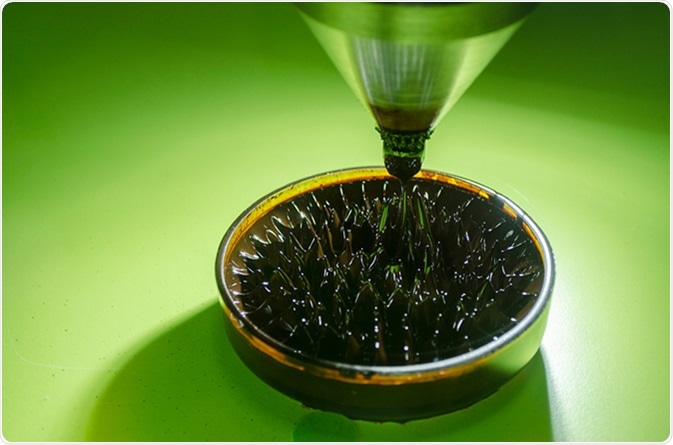Superparamagnetism occurs in ferromagnetic nanoparticles, where in the absence of a magnetic field their total average magnetism in any direction (magnetization) appears to be zero. Once in the presence of an external magnetic field they become magnetized, with their magnetic moments aligning with the field.
Nanoparticles made from iron oxide are among the most studied ferromagnetic nanoparticles with superparamagnetic properties. To exhibit superparamagnetism they must be sufficiently small (<10 nm) to allow quick fluctuations in temperature which facilitates changes in the direction of magnetization. Taking this into account, the application of an alternating magnetic field to superparamagnetic nanoparticles causes them to heat.

Behaviour of ferromagnetic fluid. Image Credit: Viktoriia Mel / Shutterstock
Nanoparticle Surface Coating
In biological applications, nanoparticles will usually be coated with organic ligands that stabilise the particles to prevent aggregation. This coating also helps to prevent the accumulation of proteins present in biological media on the surface of the particle, which would reduce their retention time within the body and potentially prevent their further function.
Specific targeting can be facilitated by the surface coating, allowing the nanoparticles to localise to a tumour, or other particular area of the body. Targeting ligands may take the form of antibodies, DNA, proteins, or other biomolecules that can interact with receptors on the surface of a target cell.
Drugs can also be conjugated with the nanoparticle, allowing for their simultaneous delivery with the arrival of the nanoparticle at the target location. The release of such drugs may be instigated by heating of the superparamagnetic nanoparticle through the application of an alternating magnetic field, or by the lower pH present in a tumour compared with healthy tissues.
The size of a nanoparticle affects its half-half circulation, extremely small nanoparticles are often removed by renal clearance and result in decreased plasma concentrations.
Superparamagnetic Nanoparticles in Bioimaging
Magnetic resonance imaging (MRI) is a common method for imaging soft tissue, which acts by the application of a strong magnetic field that causes protons in the body to align with it. Radiofrequency is then used promote the protons to a high energy state, which release energy when they fall back to a regular state, aligned with the magnetic field. The amount of energy picked up by a detector can then be used to infer the position and environment of the protons, producing a 3D image.
Superparamagnetic nanoparticles are used as contrast agents in MRI, acting in the same way as protons normally would: aligning with an external magnetic field and emitting energy upon returning to a relaxed state. Combining this feature with targeting ligands on the surface of the nanoparticle allows, for example, a tumour or lymph node to be visualised with high resolution.
Giant Magnetic Heat Induction of Magnesium-Doped gamma-Fe2O3 Superparamagnetic Nanoparticles
Superparamagnetic Nanoparticles in Hyperthermic Treatments
Hyperthermia refers to the heating of cells to induce apoptosis. Many existing hyperthermic treatments require the prior implantation of magnetic coils, but this invasive surgical step can be avoided by the use of nanoparticles coated with targeting ligands allowing them to localise to the tumour.
The application of an alternating magnetic field to superparamagnetic nanoparticles causes them to heat rapidly, which when within a cancer cell can cause proteins essential to cell survival to denature. Heats of around 42⁰C are maintained for around 30 minutes in order to ensure the successful destruction of a tumour, and this treatment may be combined with chemo- and radiotherapeutic treatments. Chemotherapeutic drugs may be delivered to the tumour by superparamagnetic nanoparticles and released upon heating, while the action of hyperthermia in denaturing repair proteins within the cell acts as a strong radiosensitizer, improving the efficacy of radiotherapy.
Further Reading
Last Updated: Feb 20, 2023